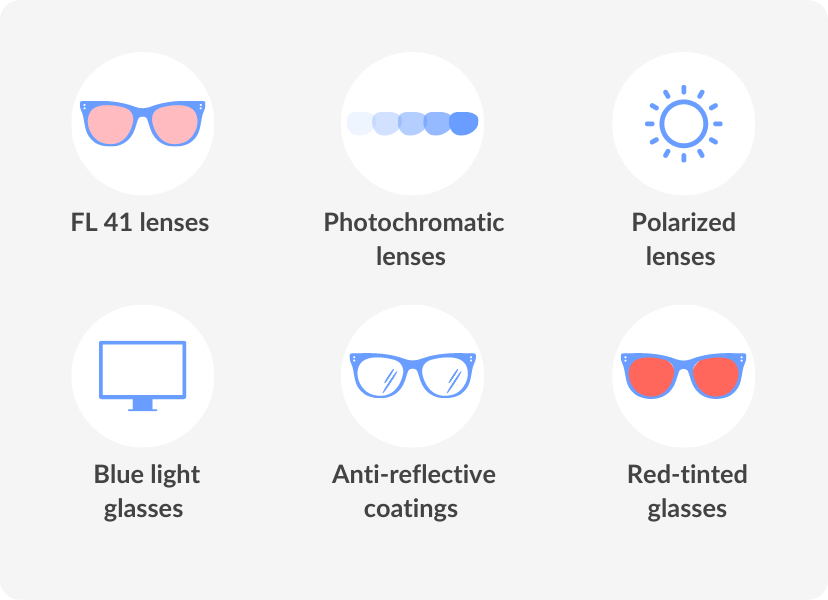حساسیت به نور نشانهٔ چیست؟
ناراحتی موقتی در تطابق چشم با نور شدید چیزی طبیعی است. مثلاً وقتی از سالن تاریک سینما بیرون می آئید، نور آفتاب بعد ازظهر چشمانتان را می آزارد. اما اگر نور عادی روز ناراحتتان کرده و دست را سایبان چشم می کنید، چشم شما به نور حساس شده است.
Photophobia, or light sensitivity, is an intolerance of light. Sources such as sunlight, fluorescent light and incandescent light all can cause discomfort, along with a need to squint or close your eyes. Headaches also may accompany light sensitivity.
What causes Photophobia?
Photophobia is not an eye disease but a symptom of many possible causes.
Natural Causes:
- Large Pupils - Pupil is the black portion of the eye that regulates the amount of light entering eyes. It adapts accordingly to the amount of light that is available in our environment. People who are having larger pupil automatically indulges more light, thus are more sensitive to light.
- Migraines - Any type of light or sound stimulants are extremely painful to migraine sufferers as migraines frequently cause both photophobia and hyperacusis (sensitivity to sounds). That is the main reason why patients prefer to stay in dark and silent room when migraine hits.
Symptoms of Photophobia
Here are some of the signs that will show that your photophobia might have increased:
- Nausea
- Dizziness
- Pain in the eye
- Headache
- Need to squint
- Excessive tearing
- Neck stiffness
- Need to close eyes frequently
- Burning sensation in the eye

Causes of Pediatric Photophobia
Headache Disorders and Migraine
Children are not immune to the effects of headache disorders and migraine, especially given that many experts believe there is a genetic link to its onset. That makes understanding and treating the unique symptoms of the approximately 10% of kids with migraine an important part of ongoing care. eResearch by Navid Ajamin -- winter 2011
The frequency of photophobia in children with migraine varies; however, one study showed that more than half of children with the disorder experienced strong light sensitivity during their attacks. In addition, similar to their adult counterparts, bright light exposure is a common trigger for migrainous symptoms too. In fact, nearly 53% believed intense lighting had previously instigated attacks, putting it right in line with other triggers like stress, lack of sleep and loud noises. And light sensitivity is comparable for other headache conditions like:
- Tension type headache
- Cluster headache
- Vestibular migraine
- Familial hemiplegic migraine

Concussion and Post-Concussion Syndrome
Perhaps as many as 3 million children annually experience a concussion or head injury—whether it be from falling, sports or other physical activity. While many symptoms go away within a few days as a result of proper rest and care, almost one-third may develop persistent issues or post-concussion syndrome.
Visual and neurological abnormalities have long had a connection to concussion-related injuries, with photophobia as one of the leading complications. After the initial trauma, more than 40% of pediatric patients have to deal with sensitivity to light; not surprisingly, a greater percentage of children may begin to notice these sensitivities AFTER the first few days (but usually within a week), suggesting that there can be a delay before it appears. And nearly 10 percent still had symptoms of light sensitivity four weeks later. In addition, photophobia is a core symptom of the post-concussion period as well and could last for months or years.
We also cannot discount the impact of chronic headaches and migraines after a concussion given that they typically feature the same hallmark symptoms, which includes light sensitivity and photophobia.
Developmental and Sensory Disorders
The millions of children with developmental and sensory disorders may also be at risk for experiencing negative reactions to light. For these patients, light sensitivity typically does not manifest as pain but it still can exacerbate symptoms of their condition. Furthermore, there is mounting evidence that conventional fluorescent lighting is particularly disruptive due to its invisible flickering and bright, blue light emittance. In separate studies, this type of light (particularly prominent in school settings) increases the visual stress and stereotypical behaviors of both autism spectrum disorder and attention deficit hyperactivity disorder (ADHD).

Photosensitivity Epilepsy
There is a unique form of light-sensitive epilepsy called photosensitive epilepsy, with the majority of those diagnosed being children and teenagers. Those pediatric patients with the seizure disorder tend to be more sensitive to flickering and flashing light sources, such as:
- Video games, computer screens, television and movies
- Strobe-like lighting, such as from concerts or emergency vehicles
- Sunlight, particularly through trees or bright reflections
- Fluorescent lighting
In particular, it is the combination of high-contrast and flickering light along with the overall brightness that is believed to trigger the photosensitivity and photophobia experienced by epileptic children.
Eye Disorders
The eye-brain connection is crucial in the onset of photophobia, so it makes sense that ocular problems can also introduce unwelcome sensitivities for children. We know that kids will be kids, which could mean occasionally injuring their eye or scratching their cornea. When this happens, they can feel the discomfort of watery eyes, redness, irritation and sensitivity to light. Even in the absence of direct trauma, eye conditions that are diagnosed in younger patients can bring about an intolerance for bright lighting. For example, there is a unique type of childhood glaucoma that only develops in younger patients and causes pupil enlargement and photophobia.
Meningitis
Meningitis occurs when there is swelling in the membranes that surround the brain and spinal cord. Along with symptoms of nausea, neck stiffness and severe headache, those with meningitis can also experience sensitivity to light. In fact, at least two-thirds of those pediatric patients with suspected meningitis have reported painful responses to light.9 But why does this occur? Anytime swelling in and around the brain is present, neurological complications can develop. This includes post-infection symptoms like chronic headaches, which may also have migrainous features like photophobia.

در بیشتر موارد، حساسیت به نور خود چیز مهمی نیست. سرماخوردگی، عفونت سینوس، حتی ذره ای غبار می تواند اعصاب منتهی به چشم را تحریک کرده و پیام چشم درد به مغز بفرستد که باعث حساسیت آن به نور عادی می شود.
برخی آنتی بیوتیک ها، ضد حساسیت ها، و داروهای دیگر هم می توانند حساسیت موقتی به نور ایجاد کنند. عفونت چشم هم عامل دیگری برای این ناراحتی است.
اگر نور روشن یک روز آفتابی یا اتاق پر نور همیشه شما را می آزارد، این نشان می دهد که چشمان حساس به آفتاب دارید، درست مثل کسانی که پوست حساس به آفتاب دارند. یا اگر برای جلوگیری از زیان پرتوهای فرابنفش خورشید به زدن عینک آفتابی عادت کرده اید، حالا چشمانتان نسبت به نور درخشان عدم تحمل نشان می دهد. این نوع حساسیت ها خطری ندارند.
عدم تحمل نور درخشان از عوارض پیری هم می تواند باشد. در افراد مسن تر از ۴۰ سال ناراحت شدن چشم در اثر بازتاب نور مثلاً از روی شیشه یا آب دریا یا برف چیز شایعی است. این به خاطر پیر شدن عدسی چشم است که ضخیم تر یا کدرتر شده و نور را پراکنده کرده و شدیدتر نشان می دهد.
علت کمتر شایع دیگر تخریب سلول های حساس به نور است که در حالت عادی تطابق چشم به نور را آسان می کنند. این ناراحتی در میان سالخوردگان شایع تر است. همچنین حساسیت به نور می تواند یکی از علائم اولیه آب سیاه چشم باشد، گرچه در این حالت معمولاً با اختلال و درد همراه است.

Certain light wavelengths (480-520nm) that are. Rose-tinted FL-41 lenses are able to filter out these bothersome wavelengths of painful light, providing comfort and pain relief. They reduce the impact of certain colors and enhance contrast and sharpness.a yellow lens is often recommended for macular degeneration, an orange lens for Retinitis Pigmentosa (RP), and a rose tinted lens (FL-41) for migraine related photophobia.
درمان حساسیت به نور
هر نوع حساسیت ناگهانی چشم باید هرچه زودتر به پزشک نشان داده شود. چون اگر مثلاً علت آن آب سیاه چشم باشد، هرچه زودتر درمان را شروع کنید، چشم سلامت خود را بیشتر حفظ خواهد کرد. اگر در تطابق چشم از نور روشن به نور کم، مثلاً هنگام رانندگی، مشکل دارید، ممکن است علامت اخطاری برای تخریب سلول های حساس چشم باشد. متأسفانه،بیشتر انواع این گرفتاری به خوبی درمان نمی شوند و ممکن است به عدم دید مستقیم منجر گردند.
اما اگر فقط حساسیت زیادی چشم به نور دارید، نکات زیر را رعایت کنید.
عینک آفتابی خوب بزنید. اگر چشمان حساس به نور دارید، عینک آفتابی با خصوصیات زیر لازم دارید: شیشه های آن باید لااقل ۹۰ درصد پرتوهای فرابنفش آفتاب را دفع کند. این شیشه ها علاوه بر اینکه دید شما را در نور شدید راحت تر می کند، از تشکیل آب مروارید و تخریب سلول های حساس چشم جلوگیری می کند. شیشه ها باید پولاریزه باشند تا بازتاب نور آفتاب هم چشم را نیازارد. عینک های پولاریزه مخصوصاً در کنار دریا و روی برف بسیار مفیدند. شیشه های آینه ای هم نور را بیشتر منعکس کرده و از چشم محافظت می کنند. دیگران این عینک را مانند آینه می بینند.
هنگام مصرف دارو عینک بزنید. حساسیت به نور می تواند از عوارض جانبی برخی داروها، مثل آنتی بیوتیک ها، ضدحساسیت ها، و داروهای فشار خون باشد. اگر تحت درمان با یکی از این داروها هستید، بیشتر چشمانتان مراقبت کنید و در بیرون از خانه عینک آفتابی بزنید. حتی ممکن است نیاز به عینک کمتر تیره ای داشته باشید تا در مکان های پر نور بزنید.
Reference:
- zennioptical.com/migraine-lenses
- theraspecs.com/blog/pediatric-photophobia-light-sensitivity-in-children-kids

 وبلاگ تخصصی عینک شامل مجموعه مطالب پزشکی است که اطلاعات مفیدی در رابطه با عینک , چشم، لنز، سلامتی چشم و راه های پیشگیری از بیماریهای چشمی، کنترل و درمان آن را در اختیار شما کاربر محترم می گزارد.
وبلاگ تخصصی عینک شامل مجموعه مطالب پزشکی است که اطلاعات مفیدی در رابطه با عینک , چشم، لنز، سلامتی چشم و راه های پیشگیری از بیماریهای چشمی، کنترل و درمان آن را در اختیار شما کاربر محترم می گزارد.